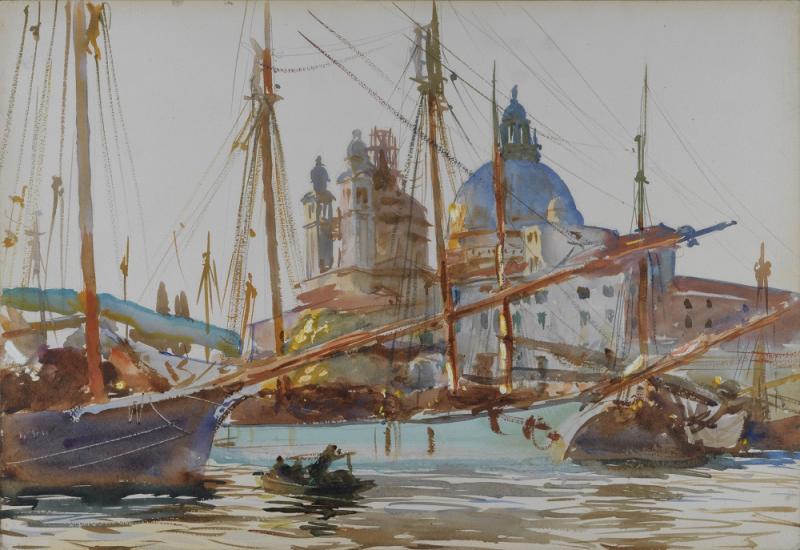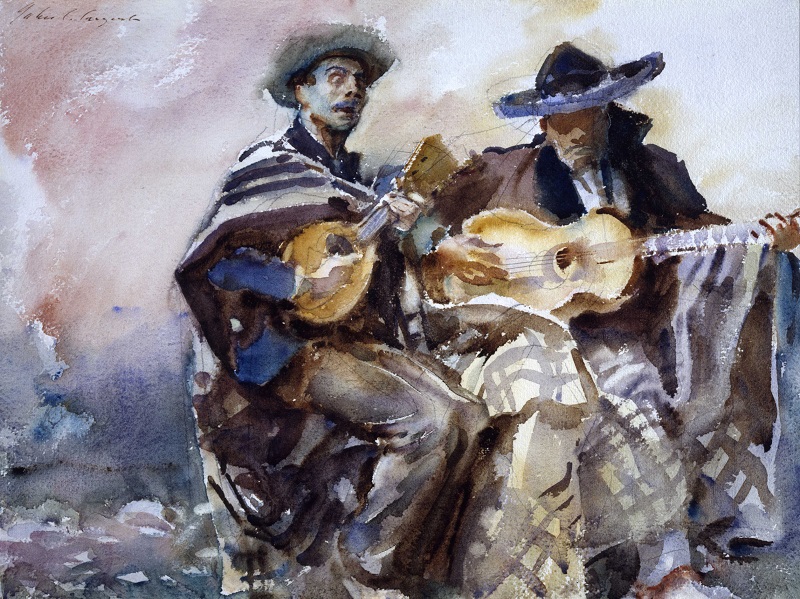Sargent, Dulwich Picture Gallery review - wonders in watercolour | reviews, news & interviews
Sargent, Dulwich Picture Gallery review - wonders in watercolour
Sargent, Dulwich Picture Gallery review - wonders in watercolour
The great portraitist lets his hair down

This sparkling display of some four score watercolours from the first decade of the last century throw an unfamiliar light on the artistry of John Singer Sargent (1856-1925), the last great swagger portrait painter in the western tradition.
As for many artists over the centuries, Venice figures large. It is a city that Sargent knew well, visiting it over some four decades. Early in the 1880s he knew its leading residents, notably a circle round the Palazzo Barbaro made up of grand East Coast American expats and the British and Italian upper classes. Paintings from the 1880s, including some of young Venetian women of the working classes, stringing beads and gossiping to amuse themselves foreshadow a growing informality. For what is striking in this selection from years later in his career is a loosening of inhibition. His lucrative portraiture practice could mean that he was captive to social expectations, but here he was in command of both his schedule and his choices, and in his own phrase, taking time off from the endless round of painting “mug shots”. Success can be imprisoning. (Pictured below: Blind Musicians, 1912)
 In many of the paintings here, the vantage point is a surprise, with many of the views of Venice taken as if from a gondola, looking over and up to buildings and boats over the shimmering water of the canals (main picture). They give the sense of a casual gaze, as though we were ourselves visitors wandering through the city, drawn by both the magnificent and the picturesque. Alongside those are exquisite close-ups of Alpine streams, studies of his sister and friends on Alpine painting holidays, and classic male nudes (no profound sexual attachment of Sargent to any gender has yet been proven, although much has been suggested: I know of no female nudes).
In many of the paintings here, the vantage point is a surprise, with many of the views of Venice taken as if from a gondola, looking over and up to buildings and boats over the shimmering water of the canals (main picture). They give the sense of a casual gaze, as though we were ourselves visitors wandering through the city, drawn by both the magnificent and the picturesque. Alongside those are exquisite close-ups of Alpine streams, studies of his sister and friends on Alpine painting holidays, and classic male nudes (no profound sexual attachment of Sargent to any gender has yet been proven, although much has been suggested: I know of no female nudes).
The compositions are also a surprise: Sargent was interested in photography, so there is an implication that the slanted, oblique views, off-centre compositions, snapshots in all but name, might have been influenced by advances in the medium. There is an affectionate tenderness, a sense of exploration and delight in the unexpected that pervades these images, regardless of subject matter.
 There is a marvellously sly mix of brush strokes – slashes, curves, rivulets, squiggles and doodles, which magically resolve into a fully realised scene. A clever exploitation of empty space is as integral and meaningful to his compositions as descriptive paint, with gouache used as tellingly as flicks of watercolour. His imaginative use of colour means that slashes of emerald and reds, purples and browns, oranges and pale blues, can convince one of the reality of stones in a stream, Venetian gondolas, Renaissance façades, wooded parks, the Mediterranean, a beach, a flowing white dress (pictured right: The Lady with the Umbrella, 1911).
There is a marvellously sly mix of brush strokes – slashes, curves, rivulets, squiggles and doodles, which magically resolve into a fully realised scene. A clever exploitation of empty space is as integral and meaningful to his compositions as descriptive paint, with gouache used as tellingly as flicks of watercolour. His imaginative use of colour means that slashes of emerald and reds, purples and browns, oranges and pale blues, can convince one of the reality of stones in a stream, Venetian gondolas, Renaissance façades, wooded parks, the Mediterranean, a beach, a flowing white dress (pictured right: The Lady with the Umbrella, 1911).
It is clear too that what he excels at is the close-up, often portraying an eye-catching detail rather than a vista; in fact, the Alpine vistas are curiously flat, almost like stage sets (pictured below: Bed of a Torrent, c.1904). What he achieved in these wonders in watercolour was a sense of changing light revealing the shapes of nature, architecture and the intricacies of the human form. No painstaking detail: instead a patchwork of colour which, close up, is staggeringly abstract, providing a convincing illusion of observed reality.
Sargent was truly cosmopolitan, described thus: an American born in Italy (to ex-pat parents in Florence), educated in France, who looked like a German, spoke like an Englishman, and painted like a Spaniard. He did not even visit his ancestral country until 1876, the centenary of American independence. In some respects he led a charmed life. He was multi-talented, a gifted linguist, a superb musician, and with a superb artistic technique that sometimes convinced critics that it was all too easy. He painted the rich, the famous, the glitterati, the literati, everyone at the top of the heap, from American presidents and Rockefeller family members to the grand expats, aristocrats and intellectuals of France and Britain. To be painted by Sargent, one wit said, was to ascend prematurely into heaven, whilst Sargent himself, all too aware of the pitfalls of portraiture, declared that a portrait was a painting where something was not quite right about the mouth.
 Developments in “modern” art, social changes, and what seemed to be his breathtaking virtuosity made for a context that easily dismissed Sargent’s manifold achievements as mindless. Rather like Whistler, Sargent dropped out of fashion and critical scrutiny until the 1980s. Recent decades have seen a substantial series of biographies, catalogues and exhibitions that have suggested a stature far beyond that of a fashionable portrait painter.
Developments in “modern” art, social changes, and what seemed to be his breathtaking virtuosity made for a context that easily dismissed Sargent’s manifold achievements as mindless. Rather like Whistler, Sargent dropped out of fashion and critical scrutiny until the 1980s. Recent decades have seen a substantial series of biographies, catalogues and exhibitions that have suggested a stature far beyond that of a fashionable portrait painter.
In this charming compilation, it is so evident he painted for pure pleasure, with a highly original sense of colour and a captivating way with composition. The result is a seductive glimpse into the architecture of his chosen cities, of scenes in Italy, France, Scotland, and the beauties of European landscape. Even the ruins of war have a poignant appeal.
- Sargent: The Watercolours at Dulwich Picture Gallery to 8 October
- Read more visual arts reviews on theartsdesk
rating
Share this article
The future of Arts Journalism
You can stop theartsdesk.com closing!
We urgently need financing to survive. Our fundraising drive has thus far raised £49,000 but we need to reach £100,000 or we will be forced to close. Please contribute here: https://gofund.me/c3f6033d
And if you can forward this information to anyone who might assist, we’d be grateful.

Subscribe to theartsdesk.com
Thank you for continuing to read our work on theartsdesk.com. For unlimited access to every article in its entirety, including our archive of more than 15,000 pieces, we're asking for £5 per month or £40 per year. We feel it's a very good deal, and hope you do too.
To take a subscription now simply click here.
And if you're looking for that extra gift for a friend or family member, why not treat them to a theartsdesk.com gift subscription?
more Visual arts
 'We are bowled over!' Thank you for your messages of love and support
Much-appreciated words of commendation from readers and the cultural community
'We are bowled over!' Thank you for your messages of love and support
Much-appreciated words of commendation from readers and the cultural community
 Photo Oxford 2025 review - photography all over the town
At last, a UK festival that takes photography seriously
Photo Oxford 2025 review - photography all over the town
At last, a UK festival that takes photography seriously
![SEX MONEY RACE RELIGION [2016] by Gilbert and George. Installation shot of Gilbert & George 21ST CENTURY PICTURES Hayward Gallery](https://theartsdesk.com/sites/default/files/styles/thumbnail/public/mastimages/Gilbert%20%26%20George_%2021ST%20CENTURY%20PICTURES.%20SEX%20MONEY%20RACE%20RELIGION%20%5B2016%5D.%20Photo_%20Mark%20Blower.%20Courtesy%20of%20the%20Gilbert%20%26%20George%20and%20the%20Hayward%20Gallery._0.jpg?itok=7tVsLyR-) Gilbert & George, 21st Century Pictures, Hayward Gallery review - brash, bright and not so beautiful
The couple's coloured photomontages shout louder than ever, causing sensory overload
Gilbert & George, 21st Century Pictures, Hayward Gallery review - brash, bright and not so beautiful
The couple's coloured photomontages shout louder than ever, causing sensory overload
 Lee Miller, Tate Britain review - an extraordinary career that remains an enigma
Fashion photographer, artist or war reporter; will the real Lee Miller please step forward?
Lee Miller, Tate Britain review - an extraordinary career that remains an enigma
Fashion photographer, artist or war reporter; will the real Lee Miller please step forward?
 Kerry James Marshall: The Histories, Royal Academy review - a triumphant celebration of blackness
Room after room of glorious paintings
Kerry James Marshall: The Histories, Royal Academy review - a triumphant celebration of blackness
Room after room of glorious paintings
 Folkestone Triennial 2025 - landscape, seascape, art lovers' escape
Locally rooted festival brings home many but not all global concerns
Folkestone Triennial 2025 - landscape, seascape, art lovers' escape
Locally rooted festival brings home many but not all global concerns
 Sir Brian Clarke (1953-2025) - a personal tribute
Remembering an artist with a gift for the transcendent
Sir Brian Clarke (1953-2025) - a personal tribute
Remembering an artist with a gift for the transcendent
 Emily Kam Kngwarray, Tate Modern review - glimpses of another world
Pictures that are an affirmation of belonging
Emily Kam Kngwarray, Tate Modern review - glimpses of another world
Pictures that are an affirmation of belonging
 Kiefer / Van Gogh, Royal Academy review - a pairing of opposites
Small scale intensity meets large scale melodrama
Kiefer / Van Gogh, Royal Academy review - a pairing of opposites
Small scale intensity meets large scale melodrama
 Jenny Saville: The Anatomy of Painting, National Portrait Gallery review - a protégé losing her way
A brilliant painter in search of a worthwhile subject
Jenny Saville: The Anatomy of Painting, National Portrait Gallery review - a protégé losing her way
A brilliant painter in search of a worthwhile subject
 Abstract Erotic, Courtauld Gallery review - sculpture that is sensuous, funny and subversive
Testing the boundaries of good taste, and winning
Abstract Erotic, Courtauld Gallery review - sculpture that is sensuous, funny and subversive
Testing the boundaries of good taste, and winning
 Edward Burra, Tate Britain review - watercolour made mainstream
Social satire with a nasty bite
Edward Burra, Tate Britain review - watercolour made mainstream
Social satire with a nasty bite

Add comment